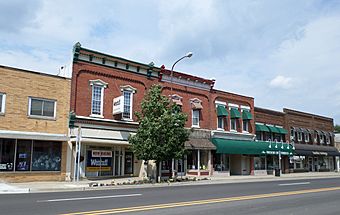West Town Historic Commercial and Industrial District facts for kids
Quick facts for kids |
|
|
West Town Historic Commercial and Industrial District
|
|
 |
|
| Location | Main St., Owosso, Michigan |
|---|---|
| Area | 13 acres (5.3 ha) |
| Architectural style | Italianate, Romanesque |
| MPS | Owosso MRA |
| NRHP reference No. | 80001911 |
| Added to NRHP | November 4, 1980 |
The West Town Historic Commercial and Industrial District is a special area in Owosso, Michigan. It has old shops and factories that tell a story about the city's past. This district is located along Main Street, between Cedar and State streets. It was added to the National Register of Historic Places in 1980. This means it's an important place that the United States government wants to protect because of its history.
Why is West Town Historic?
Owosso started growing near the Shiawassee River. But things changed a lot in 1856 when the first train line, the Detroit and Milwaukee Railway, came to town. By 1867, two more train lines arrived. By the 1880s, Owosso had four train lines! This made the southwest part of the city a very busy place for trains.
Factories soon realized that building near the train tracks was a smart idea. It made it cheaper and easier to move their products. Many workers moved close to these new factories. To serve these new neighborhoods, a small area with shops and businesses grew on Main Street. This area became the West Town Historic District.
What Does the District Look Like?
The West Town Historic District is a mix of old shops and factory buildings. There are 35 buildings in total. Many of these buildings are quite old. Thirteen of them were built between 1856 and the 1890s. Another fifteen were built around the early 1900s, up until the time of the Great Depression. Most of the other buildings also fit in well with the old style of the area.
The shops along Main Street are mostly two-story buildings made of brick. They have cool details made from cast iron, tin, stone, and tile. The older buildings often show an Italianate design, which was a popular style back then. Later buildings have a simpler, more modern look. The factory part of the district, which was closer to the train tracks, has lost many of its original buildings over time.

